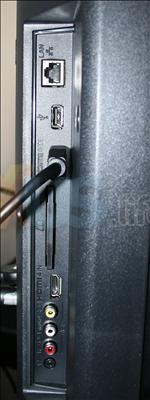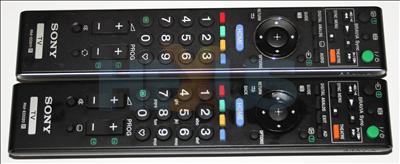Sony's 40W5810 with freesat HD
Coming back to the review model, the Sony 40W5810 freesat HD-enabled TV is finished in the piano black style used by most in the BRAVIA range. Indeed the design has barely changed in the interim time between the W4500 and W5500/5810. The aesthetic is more functional than jaw-droppingly beautiful, and the thick-ish bezel makes it seem a little smaller than it is.Also available in 32in, 37in, 46in and 52in models, the TV's controls have been moved from the very top to the right-hand side, which makes sense as the previous generation set's bezel was prone to smudging at the top. A side-on shot also highlights that the 40in set is of average thickness, measuring 9.3cm deep - so it will sit equally happy on a wall as on a stand. A couple of recessed handles on the rear make handling the 21.3kg set pretty straightforward.
Most users will opt for the supplied table stand, which is sturdy and can be attached in under a minute. The built-in swivel provides around 20° of adjustment either way - a little more wouldn't hurt, though.
The very latest LCD TVs from Samsung have the edge in terms of looks, so we'd like to see Sony add a little more flair to its mainstream range. It's no ugly duckling, sure, but you probably won't be buying it for the immediate wow factor.
General connectivity is good. Four HDMI inputs should sate most users and the inclusion of both Ethernet and USB ports enables the viewing of both pictures and movies. Sony's AppliCast technology enables the use of basic widgets, via the Ethernet port and online, for items such as screensavers, RSS readers, and world clock. These are on top of the built-in widgets for a clock and calendar.
Pragmatically, as a freesat HD model, there's the requisite aerial input at the back, but, naturally, you will need to connect a dish - a Sky one will do - to receive a signal: more on this later. A couple of SCART connectors are provided for what are becoming almost legacy items, and an HD15 input is useful for hooking up a PC if HDMI isn't available.
Basic setup is simple enough. Sony's XrossMediabar system is intuitive and whilst keeping the bases covered, doesn't offer a bewildering, overpowering range of options. As always, it's worth playing around with the various settings to see what suits your eye best, and each input's can be set and stored separately.
Set to a backlight level of four, the power-saving feature further dims the display in order to reduce energy usage. When no power-saving is activated the TV draws around 125W, switch it to low and it drops to around 100W. Put it on high, however, and whilst the picture becomes a touch soft and a little dark, power-draw drops to an eco-friendly 65W - not at all bad for a 40in set.
Sony's remote controls have remained fairly similar over time. The W5810's controller (RM-ED020, bottom) is practically identical to the W4500's (RM-ED011, top). Want to know the technical details of the set? Head on over to here.







